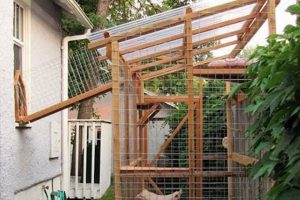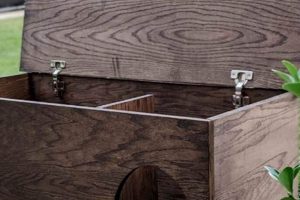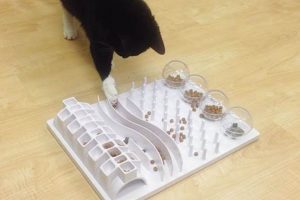A feline shelter constructed for external placement, typically assembled by an individual, provides protection from the elements for domestic or feral animals. Such structures often incorporate insulation and weather-resistant materials to ensure warmth and dryness. For example, a repurposed plastic storage container, modified with an entrance and insulated with straw, can serve as a readily implemented outdoor cat shelter solution.
Provisioning weather-resistant housing for felines contributes to their health and well-being, mitigating the risks associated with exposure to cold, heat, and precipitation. These shelters provide crucial refuge, particularly for animals lacking permanent indoor access. Historically, concerned citizens and animal welfare organizations have engaged in constructing and distributing such shelters to manage and protect community cat populations.
The subsequent sections will explore specific designs for feline outdoor shelters, material selection considerations, construction techniques suitable for various skill levels, and strategies for encouraging feline habitation of the completed structure.
Construction Recommendations for Feline Outdoor Shelters
The following recommendations aim to enhance the durability, functionality, and appeal of shelters designed for outdoor use by felines.
Tip 1: Material Selection: Prioritize weather-resistant materials such as treated lumber, durable plastics, or repurposed shipping containers. These materials minimize degradation due to moisture and temperature fluctuations, extending the structure’s lifespan.
Tip 2: Insulation Implementation: Incorporate insulation materials like rigid foam boards or straw to maintain a stable internal temperature. Avoid fiberglass insulation, as it can pose a health risk to felines if ingested or inhaled.
Tip 3: Entrance Design: Design the entrance to be appropriately sized, typically between six and eight inches in diameter, to prevent access by larger predators while allowing easy entry and exit for felines. Consider an offset or tunnel entrance to further minimize wind and rain exposure.
Tip 4: Weatherproofing Techniques: Seal seams and joints with waterproof caulk or sealant to prevent water infiltration. A slightly sloped roof facilitates water runoff, reducing the risk of leaks and structural damage.
Tip 5: Ventilation Considerations: Provide adequate ventilation to prevent moisture buildup and promote air circulation. Small, covered vents near the roofline can effectively manage condensation without compromising insulation.
Tip 6: Elevated Base Construction: Construct the shelter on an elevated base, such as cinder blocks or pressure-treated lumber, to protect it from ground moisture and potential flooding. This also improves insulation and reduces the risk of pest infestation.
Tip 7: Camouflage and Placement: Consider camouflaging the shelter with natural colors or vegetation to blend it into the surrounding environment. Place the shelter in a sheltered location, away from heavy traffic and potential disturbances, to maximize feline comfort and security.
These recommendations, when implemented thoughtfully, contribute to the creation of safe and effective outdoor shelters, enhancing the well-being of felines reliant on external housing.
The subsequent section will address potential issues and provide troubleshooting solutions for common challenges encountered in the maintenance and utilization of feline outdoor shelters.
1. Design
The design phase is fundamental to the successful implementation of any feline outdoor shelter construction project. Design considerations dictate structural integrity, weather resistance, and the overall suitability of the dwelling for its intended occupants. A poorly designed shelter may offer inadequate protection from the elements, rendering it useless or even detrimental to feline health. For example, a design lacking sufficient roof overhang may allow rainwater to enter the shelter, soaking the insulation and creating a cold, damp environment. Similarly, an inappropriately sized entrance could permit access by larger predators, compromising the safety of the cats.
Effective design encompasses several key elements. The size of the shelter must be adequate to accommodate one or more cats comfortably, allowing them to turn around and nest. The entrance design should minimize exposure to wind and rain while preventing entry by unwanted animals. Internal features, such as a raised floor or separate compartments, can enhance insulation and provide added security. The overall aesthetic design may also influence the acceptance of the shelter by both the cats and the surrounding community. A well-designed shelter integrates seamlessly into its environment, reducing its visual impact and minimizing potential objections from neighbors.
In conclusion, the design of a feline outdoor shelter is not merely an aesthetic consideration but a critical factor determining its functionality and effectiveness. Thoughtful planning and attention to detail during the design phase translate directly into a safer, more comfortable, and more durable dwelling for felines. Failure to prioritize design can result in a shelter that fails to meet its intended purpose, ultimately jeopardizing the well-being of the animals it is meant to protect.
2. Materials
The selection of appropriate materials constitutes a critical determinant in the success and longevity of any feline outdoor shelter construction. The materials directly impact the structure’s ability to withstand environmental stressors, provide adequate insulation, and maintain a safe and sanitary environment for the animal occupants. Inadequate material selection can lead to premature degradation of the structure, ineffective protection from the elements, and potential health hazards for the felines. For instance, using untreated wood in a damp climate will result in rapid rot and structural failure, necessitating frequent repairs or replacements. Conversely, employing non-breathable materials can trap moisture inside the shelter, leading to the growth of mold and mildew, posing respiratory risks to the cats. Furthermore, materials with sharp edges or toxic components can cause injury or illness.
Specific material choices necessitate careful consideration. Pressure-treated lumber, while resistant to rot and insect infestation, should be thoroughly dried and sealed to minimize the leaching of chemicals. Durable plastics offer weather resistance and ease of cleaning but may lack insulation properties, requiring supplemental insulation materials. Straw provides effective and natural insulation but requires regular replacement to prevent moisture buildup and decomposition. Insulation materials must be non-toxic and resistant to moisture absorption. Recycled materials, such as shipping pallets or plastic containers, can offer cost-effective and environmentally friendly solutions, provided they are properly cleaned and modified to ensure safety and weather resistance. The roofing material should be waterproof and durable, such as asphalt shingles or metal roofing, to prevent leaks and protect the shelter’s interior from the elements.
In summary, the materials utilized in feline outdoor shelter construction are not merely components but rather fundamental determinants of the structure’s performance and the well-being of its inhabitants. Thoughtful selection, informed by an understanding of material properties and environmental conditions, is paramount. Challenges in material selection often involve balancing cost, durability, and environmental impact. Prioritizing high-quality, weather-resistant, and non-toxic materials ensures a safe, comfortable, and long-lasting shelter for vulnerable feline populations.
3. Insulation
Insulation constitutes a crucial component within the context of feline outdoor shelter construction. The efficacy of a shelter in protecting its inhabitants from adverse weather conditions is directly proportional to the effectiveness of its insulation. Without adequate insulation, an outdoor structure provides minimal defense against extreme temperatures, rendering it essentially an open-air enclosure. The purpose of insulation is to impede the transfer of heat, maintaining a more stable internal temperature regardless of external fluctuations. In cold climates, insulation minimizes heat loss from the animal’s body, preventing hypothermia. Conversely, in hot climates, it reduces the influx of external heat, protecting the animal from overheating. The absence of proper insulation negates a primary function of the shelter, potentially endangering the animal’s health and survival.
Various materials can be employed for insulation, each exhibiting distinct thermal properties and suitability for different climates. Straw, a readily available and cost-effective option, provides moderate insulation and breathability. Rigid foam boards, such as polystyrene or polyurethane, offer superior insulation performance and moisture resistance, but require careful installation to prevent air gaps. Reflective bubble wrap insulation can be effective in reflecting radiant heat, particularly in hot climates. The choice of insulation material should be informed by a thorough assessment of the prevailing climate, the animal’s specific needs, and the overall design of the shelter. For instance, in regions experiencing prolonged periods of sub-freezing temperatures, a combination of rigid foam board insulation and a thick layer of straw may be necessary to achieve optimal thermal protection.
In conclusion, insulation is not merely an optional feature but an indispensable element in the construction of functional and effective feline outdoor shelters. Its presence directly impacts the animal’s ability to thermoregulate and survive in challenging environmental conditions. Therefore, meticulous attention must be paid to the selection, installation, and maintenance of insulation materials to ensure the shelter provides a safe and comfortable refuge for its intended occupants. Challenges in insulation often involve balancing cost, effectiveness, and environmental impact, alongside consideration for potential moisture-related issues that can compromise insulation performance.
4. Location
The selection of a suitable location is paramount to the successful utilization of a feline outdoor shelter. The placement of the structure directly influences its accessibility, protection from the elements, and overall acceptance by the intended feline inhabitants. A poorly chosen location may render the shelter unusable, exposing the animals to continued hardship despite the provision of a physical refuge. For instance, a shelter placed in a high-traffic area is unlikely to be utilized by feral or skittish felines, as they will perceive it as a potential threat. Similarly, a location exposed to prevailing winds or direct sunlight will negate the benefits of insulation, rendering the shelter uncomfortably cold or hot, respectively.
Optimal placement involves several key considerations. The shelter should be situated in a sheltered area, shielded from wind, rain, and snow. A location near existing structures, such as sheds or fences, can provide additional protection. Proximity to a reliable food and water source may also encourage utilization. However, the shelter should not be placed in an area prone to flooding or pest infestation. Camouflaging the shelter with natural vegetation or placing it in a secluded spot can enhance its appeal to wary felines. For example, shelters placed under dense shrubs or behind stacks of firewood are often readily accepted by feral cat colonies. Furthermore, consideration should be given to minimizing the shelter’s visibility to potential predators or disruptive human activity.
In conclusion, the location of a feline outdoor shelter is not a trivial decision but a critical factor determining its effectiveness and the well-being of its inhabitants. Thoughtful placement, informed by an understanding of feline behavior and environmental conditions, is essential. Challenges often involve balancing the need for protection from the elements with the desire to maintain accessibility and minimize disruption to the surrounding environment. Ultimately, a well-placed shelter provides a safe, secure, and comfortable refuge, contributing significantly to the health and survival of vulnerable feline populations.
5. Size
The dimensions of a feline outdoor shelter, a critical design parameter, directly influence its functionality and suitability for the intended occupants. Size considerations encompass both internal space and external dimensions, impacting factors such as thermal regulation, occupant capacity, and ease of placement.
- Internal Volume and Occupant Comfort
The interior volume dictates the degree of comfort afforded to the feline inhabitants. Insufficient space can lead to overcrowding, stress, and increased competition for resources, while excessive space may reduce the effectiveness of the shelter’s thermal insulation. A single cat typically requires a minimum of 18 inches in each dimension to comfortably turn around and nest. Larger shelters may accommodate multiple cats but necessitate careful consideration of social dynamics and resource allocation to prevent conflict.
- External Dimensions and Site Integration
The exterior dimensions must align with the available space at the intended location. A shelter too large for the designated site may obstruct pathways, impede landscaping efforts, or violate property restrictions. Conversely, a shelter that is excessively small may be less effective at providing protection from the elements. External dimensions also influence the ease of transportation and installation. Modular designs or prefabricated components may facilitate assembly and placement in challenging locations.
- Entrance Size and Security
The size of the entrance aperture is a critical security consideration. An overly large entrance may permit access by larger predators, compromising the safety of the felines. Conversely, an entrance that is too small may deter reluctant cats from utilizing the shelter. A typical entrance size ranges from six to eight inches in diameter, striking a balance between accessibility and security. Tunnel entrances or offset designs can further enhance security by limiting direct visibility into the shelter’s interior.
- Material Quantity and Cost Implications
The overall size of the shelter directly affects the quantity of materials required for construction, influencing the project’s overall cost. Larger shelters necessitate more lumber, insulation, and roofing materials, increasing the financial burden. Optimizing the size to meet the specific needs of the feline population while minimizing material waste is a key cost-saving strategy. Repurposing existing materials or utilizing cost-effective building techniques can further mitigate expenses.
In conclusion, the size of a do-it-yourself feline outdoor shelter represents a multifaceted design challenge, requiring careful consideration of occupant comfort, site constraints, security concerns, and budgetary limitations. A well-proportioned shelter optimizes functionality and contributes significantly to the well-being of its feline inhabitants.
6. Durability
Durability constitutes a paramount attribute within the realm of feline outdoor shelter construction. The lifespan and protective capabilities of a shelter are directly contingent upon its ability to withstand the rigors of environmental exposure, physical stress, and biological degradation. A lack of inherent durability can result in premature structural failure, compromising the shelter’s effectiveness and necessitating frequent repairs or replacements. The connection between a robust shelter and feline well-being is undeniable; a structure prone to damage provides inadequate protection from weather, predators, and other external threats. As an example, a shelter constructed from untreated wood in a region with high humidity is likely to succumb to rot within a short timeframe, rendering it structurally unsound and unsafe for habitation. Therefore, careful material selection and construction techniques are essential to ensure the longevity and efficacy of the shelter.
The selection of weather-resistant materials, such as pressure-treated lumber, durable plastics, or metal roofing, plays a critical role in enhancing durability. Additionally, proper construction techniques, including secure joinery, waterproof sealing, and robust structural bracing, contribute significantly to the shelter’s ability to withstand external forces. For instance, a shelter constructed with overlapping roof panels and sealed seams is less susceptible to water intrusion, preventing the deterioration of internal insulation and structural components. Furthermore, implementing preventative maintenance measures, such as periodic inspections and timely repairs, can further extend the shelter’s lifespan and ensure its continued functionality. In locations prone to extreme weather events, such as high winds or heavy snowfall, the shelter’s design must incorporate features that enhance its stability and resistance to damage. A low profile design, coupled with secure anchoring to the ground, can mitigate the risk of wind damage, while a steeply pitched roof can prevent snow accumulation.
In summation, durability is not merely a desirable characteristic but a fundamental requirement for any feline outdoor shelter intended to provide long-term protection and security. The investment in durable materials and sound construction techniques yields significant returns in terms of extended lifespan, reduced maintenance costs, and, most importantly, enhanced welfare for the animals it shelters. Challenges in achieving optimal durability often involve balancing cost considerations with the need for long-term performance. However, prioritizing durability ultimately proves more cost-effective in the long run by minimizing the need for repairs or replacements. By focusing on durability, builders can ensure that their shelters provide a safe and reliable haven for felines facing the challenges of outdoor living.
Frequently Asked Questions
This section addresses common inquiries and misconceptions regarding the construction and utilization of outdoor shelters for felines. The following questions and answers aim to provide clear, concise, and objective information to assist in the effective implementation of shelter projects.
Question 1: What constitutes an appropriate size for a feline outdoor shelter?
An adequately sized shelter should accommodate at least one adult cat comfortably, allowing it to turn around and lie down without constraint. A minimum internal dimension of 18 inches in each direction is generally recommended. Shelters intended for multiple cats should be proportionally larger to prevent overcrowding and competition for resources.
Question 2: What materials are best suited for constructing a weather-resistant feline shelter?
Pressure-treated lumber, durable plastics, and repurposed shipping containers offer effective weather resistance. Roofing materials should be waterproof, such as asphalt shingles or metal. Insulation materials, such as straw or rigid foam board, should be non-toxic and moisture-resistant.
Question 3: How can a feline outdoor shelter be effectively insulated?
Insulation materials can be installed within the walls, floor, and roof of the shelter. Rigid foam boards provide excellent insulation, while straw offers a more natural and breathable option. Ensure proper sealing to prevent moisture infiltration and maintain insulation effectiveness.
Question 4: Where is the most appropriate location to place a feline outdoor shelter?
The shelter should be located in a sheltered area, protected from wind, rain, and direct sunlight. Placement near existing structures or natural vegetation can provide additional concealment and protection. Avoid locations prone to flooding or pest infestation.
Question 5: How can a shelter’s entrance be designed to deter predators?
A small entrance size, typically six to eight inches in diameter, can deter larger predators. Tunnel entrances or offset designs further limit visibility into the shelter’s interior, enhancing security. Consider incorporating a raised threshold to prevent water intrusion.
Question 6: How often should a feline outdoor shelter be cleaned and maintained?
Regular cleaning, at least monthly, is recommended to remove debris, pests, and soiled bedding. Replace soiled insulation materials as needed to maintain a sanitary environment. Inspect the shelter regularly for structural damage and perform necessary repairs promptly.
Effective construction and maintenance of outdoor shelters are essential to ensure the safety and well-being of feline populations reliant on external housing. Adherence to best practices in design, material selection, and location is critical for maximizing the shelter’s utility and longevity.
The subsequent section will address potential funding sources and resource availability for feline outdoor shelter construction projects.
Conclusion
This exploration of feline shelter construction, commonly referred to as “cat house outdoor diy,” has underscored several critical factors that influence the efficacy and durability of such structures. Material selection, insulation techniques, site placement, and size considerations all play vital roles in ensuring the shelter’s ability to provide a safe and comfortable refuge for vulnerable feline populations. The construction process, whether undertaken by individuals or organizations, requires careful planning and adherence to best practices to maximize its beneficial impact.
The provision of adequately constructed and strategically located feline outdoor shelters represents a tangible contribution to animal welfare, particularly for community cats lacking access to indoor environments. Continued efforts in research, resource allocation, and community engagement are essential to further refine shelter designs, promote responsible construction practices, and expand the availability of these critical resources for felines in need. The long-term benefits of such initiatives extend beyond individual animals, contributing to the overall health and stability of feline populations and fostering a more compassionate approach to animal welfare within communities.







